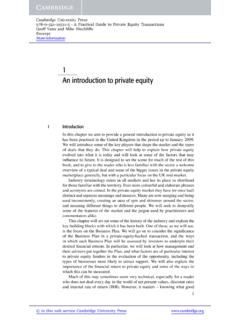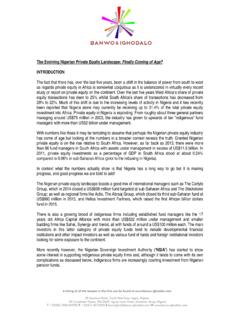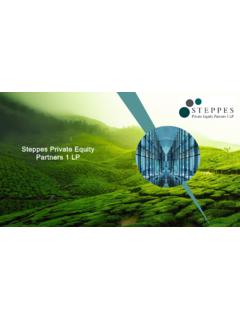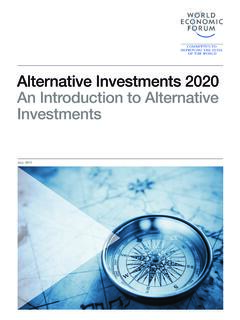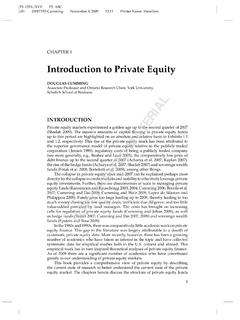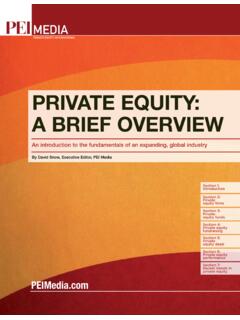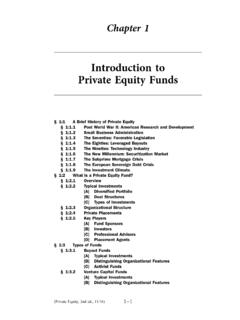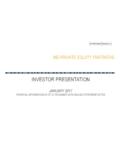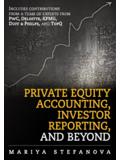Transcription of Chapter 1
1 11 Chapter 1 private equity : Investors as ManagersAidells Sausage Company was founded by Bruce Aidell in 1983. A microbiologist and foodie, he developed an artisanal line of chicken sausage products that were widely popular in the San Francisco Bay Area. In 2007 private equity firm Encore Consumer Capital bought the company, provided financial management and operational and marketing expertise, and dramatically expanded its market reach. The company had grown from 140 to 350 employees by 2010, when it was sold to Sara s Department Store chain was another well-known and popu-lar brand serving the Bay Area and other cities throughout California when it was acquired by a private equity consortium led by Sun Capital Partners: in 2004 its 257 stores and 30,000 employees were acquired in a leveraged buyout worth $ billion.
2 The private equity firms paid $400 million of their own and their investors cash and debt-financed $800 million using the company s assets as collateral. They soon sold off the property assets, retiring the debt backed by those assets and paying themselves back. The stores were required to lease back the property that housed their operations and pay inflated rents on facilities they had pre-viously owned. The consortium then had the department store chain take on $400 million in additional debt and used the funds to pay dividends to its private equity owners. The store managers were required to make across-the-board job cuts and were unable to maintain long-term rela-tions with vendors. Several rounds of top management left. Mervyn s filed for bankruptcy in 2008: the department store chain had a $64 million loss that year less than the $80 million increase in rent payments follow-ing the buyout by private equity .
3 Over the four years of private equity ownership, 30,000 people lost their equity firms have emerged in the last three decades as part of a group of new financial actors or intermediaries that raise large pools of capital from wealthy individuals and institutions for investment funds. 13/3/14 1:12 PM2 private equity at WorkThese funds undertake risky investments that promise to deliver higher-than-average returns. private equity funds buy out companies using high levels of debt referred to as leverage that is loaded onto the acquired companies. The use of debt to take over ownership of mature operating companies in leveraged buyouts and actively manage them are the char-acteristics that distinguish private equity funds from venture capital or hedge funds. Venture capital and hedge funds are also investment funds that mobilize private pools of capital, but their business models differ substantially from that of private Do We Focus on private equity ?
4 We undertook an examination of private equity (PE) in this book because it is the financial intermediary that has the most direct effect on the man-agement of mainstream businesses in the economy. In 2013, 2,797 private equity firms were headquartered in the United States, with invest-ments in 17,744 companies, according to the private equity Growth Capital Council (PEGCC), the industry s association and chief lobbying group. Since 2000, PE-owned companies have employed some million people. Roughly 35 percent of PE investments come from pension funds, especially public pension funds. Thus, the actions of private equity partners affect not only the employees in the companies they own and the suppliers with whom they do business, but also the retirement income of millions of working and retired companies are similar to publicly held companies in sev-eral ways.
5 Both are under pressure to maximize short-term shareholder value and have an array of financial and organizational strategies to do this. But there are also fundamental differences between them that lead to differences in managerial risk-taking and in stakeholder outcomes. The financial structure and light legal regulation of private equity firms allow them to much more aggressively pursue shareholder value at the expense of others with a stake in the company its suppliers, employees, custom-ers, and key difference between publicly traded companies and those owned by private equity lies in the way partners in private equity firms are rewarded. In the leveraged buyouts undertaken by PE funds, about 70 per-cent is funded by debt and the remaining 30 percent by equity , which comes almost entirely from the funds outside investors. The general partner (GP) in the PE fund, who is a partner in the private equity firm that sponsored the fund, makes the decisions about which companies to acquire for the fund s portfolio, how much debt to use, and how to manage the compa-nies.
6 General partners invest 1 to 2 percent of the equity in the PE fund but receive 20 percent of the returns once the fund achieves a hurdle usually an 8 percent rate of return. The structure of these deals allows the 23/3/14 1:12 PM Investors as Managers 3 GPs to take high risks using other people s money. Their goal is to sell the portfolio company in three to five years at a higher price than they paid to acquire it. The downside of the extensive use of debt is that it increases the risk that the portfolio company will experience financial distress. On the upside, however, debt magnifies the returns to the private equity fund. The general partner, who has put up 2 percent or less of the equity , has little at stake if debt drives the acquired company into bankruptcy, but much to gain from a successful exit from the investment.
7 This is a classic case of what economists call moral hazard. The general partner who makes the decision to load the portfolio company with debt that it is obligated to repay bears very little of the potential costs associated with those other differences are worth highlighting. First, the compa-nies that private equity firms take private are lightly regulated by the Securities and Exchange Commission (SEC) and thus are lightly subject to the same requirements for transparency and accountability as public companies. The general partners can require the portfolio companies to pay them personally, collecting advisory fees and management fees that can run into millions of dollars annually; no CEO of a publicly traded company can make any such requirement of the company s divisions or subsidiaries. The GPs can also use other financial engineering strategies that would be unacceptable for public corporations to undertake owing to their adverse reputational consequences and shareholder opposition.
8 Second, investors in private equity funds turn over full decision-making power to the general partner of the fund and make a capital commitment for the life of the fund, typically ten years. As a result, PE general partners are not subject to the kind of immediate shareholder pressure or public scrutiny that public companies face. Shareholders in public companies are typically more risk-averse and can pull out their money at any difference in transparency and shareholder accountability allows private equity to take on substantially more debt than public companies. private equity turns on its head the capital structure of the typical pub-lic corporation: the capital structure of a company acquired by a private equity fund is often 70 percent debt and 30 percent equity , whereas the structure of a publicly traded company is typically 30 percent debt and 70 percent equity .
9 High debt is a high-risk strategy that, when successful, enables outsized returns for the private equity fund; but it also increases the likelihood of financial distress and bankruptcy for portfolio com-panies, especially in economic downturns. The empirical evidence we review shows that private equity owned companies historically have had twice the bankruptcy rates of publicly traded companies, and these rates were particularly high after the economic recession of 2007 , the law treats PE firms and their funds as investors, even though they behave as managers of the companies they buy and sell and as employ-ers of the people who work in those companies. PE funds both own and 33/3/14 1:12 PM4 private equity at Worktake control of companies, appoint boards of directors, hire and fire top executives, and set the direction of business strategy and employment policies.
10 The general partners and their legal team often negotiate directly with unions in collective bargaining or demand concessions in wages and benefits as a condition of taking over the company. Unlike public compa-nies, however, they are not held legally or publicly accountable for many of the outcomes of their decisions, a pattern we document throughout the book. When something goes wrong in a private equity owned company, the negative reputational effect typically falls on the company itself, as the private equity owner is behind the scenes with little fundamental differences between private equity owned and pub-lic corporations are summarized in table When private equity firms take over companies, moral hazard problems often ensue because the general partners in these firms, in a position to make greater use of other people s money than their own, engage in high-risk behaviors.



